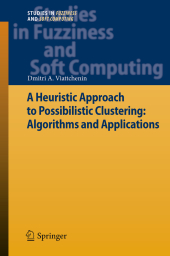 Neuerscheinungen 2015Stand: 2020-02-01 |
Schnellsuche
ISBN/Stichwort/Autor
|
Herderstraße 10
10625 Berlin
Tel.: 030 315 714 16
Fax 030 315 714 14
info@buchspektrum.de |

Dmitri A. Viattchenin
A Heuristic Approach to Possibilistic Clustering: Algorithms and Applications
2013. 2015. xii, 227 S. 235 mm
Verlag/Jahr: SPRINGER, BERLIN; SPRINGER BERLIN HEIDELBERG 2015
ISBN: 3-642-44301-X (364244301X)
Neue ISBN: 978-3-642-44301-5 (9783642443015)
Preis und Lieferzeit: Bitte klicken
In a new approach to possibilistic clustering, the sought clustering structure of the set is based directly on the formal definition of fuzzy cluster and possibilistic memberships are determined directly from the values of the pairwise similarity of objects.
The present book outlines a new approach to possibilistic clustering in which the sought clustering structure of the set of objects is based directly on the formal definition of fuzzy cluster and the possibilistic memberships are determined directly from the values of the pairwise similarity of objects. The proposed approach can be used for solving different classification problems. Here, some techniques that might be useful at this purpose are outlined, including a methodology for constructing a set of labeled objects for a semi-supervised clustering algorithm, a methodology for reducing analyzed attribute space dimensionality and a methods for asymmetric data processing. Moreover, a technique for constructing a subset of the most appropriate alternatives for a set of weak fuzzy preference relations, which are defined on a universe of alternatives, is described in detail, and a method for rapidly prototyping the Mamdani´s fuzzy inference systems is introduced. This book addresses engineers, scientists, professors, students and post-graduate students, who are interested in and work with fuzzy clustering and its applications
Introduction.- Heuristic Algorithms of Possibilistic Clustering.- Clustering Approaches for the Uncertain Data.- Applications of the Heuristic Algorithms of Possibilistic Clustering.


